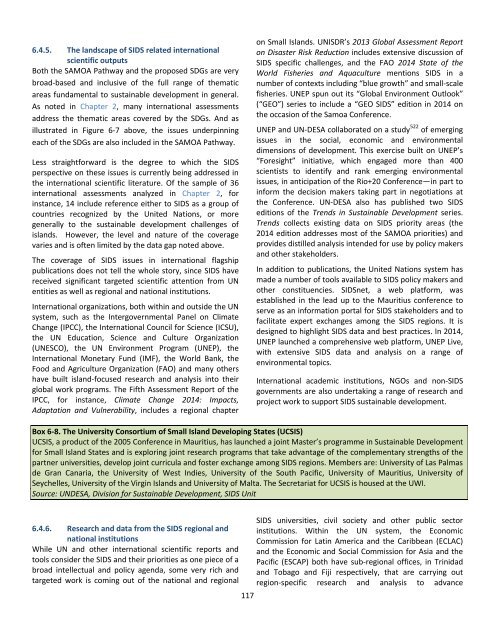1HlG51J
1HlG51J
1HlG51J
You also want an ePaper? Increase the reach of your titles
YUMPU automatically turns print PDFs into web optimized ePapers that Google loves.
6.4.5. The landscape of SIDS related internationalscientific outputsBoth the SAMOA Pathway and the proposed SDGs are verybroad-based and inclusive of the full range of thematicareas fundamental to sustainable development in general.As noted in Chapter 2, many international assessmentsaddress the thematic areas covered by the SDGs. And asillustrated in Figure 6-7 above, the issues underpinningeach of the SDGs are also included in the SAMOA Pathway.Less straightforward is the degree to which the SIDSperspective on these issues is currently being addressed inthe international scientific literature. Of the sample of 36international assessments analyzed in Chapter 2, forinstance, 14 include reference either to SIDS as a group ofcountries recognized by the United Nations, or moregenerally to the sustainable development challenges ofislands. However, the level and nature of the coveragevaries and is often limited by the data gap noted above.The coverage of SIDS issues in international flagshippublications does not tell the whole story, since SIDS havereceived significant targeted scientific attention from UNentities as well as regional and national institutions.International organizations, both within and outside the UNsystem, such as the Intergovernmental Panel on ClimateChange (IPCC), the International Council for Science (ICSU),the UN Education, Science and Culture Organization(UNESCO), the UN Environment Program (UNEP), theInternational Monetary Fund (IMF), the World Bank, theFood and Agriculture Organization (FAO) and many othershave built island-focused research and analysis into theirglobal work programs. The Fifth Assessment Report of theIPCC, for instance, Climate Change 2014: Impacts,Adaptation and Vulnerability, includes a regional chapteron Small Islands. UNISDR’s 2013 Global Assessment Reporton Disaster Risk Reduction includes extensive discussion ofSIDS specific challenges, and the FAO 2014 State of theWorld Fisheries and Aquaculture mentions SIDS in anumber of contexts including “blue growth” and small-scalefisheries. UNEP spun out its “Global Environment Outlook”(“GEO”) series to include a “GEO SIDS” edition in 2014 onthe occasion of the Samoa Conference.UNEP and UN-DESA collaborated on a study 522 of emergingissues in the social, economic and environmentaldimensions of development. This exercise built on UNEP’s“Foresight” initiative, which engaged more than 400scientists to identify and rank emerging environmentalissues, in anticipation of the Rio+20 Conference—in part toinform the decision makers taking part in negotiations atthe Conference. UN-DESA also has published two SIDSeditions of the Trends in Sustainable Development series.Trends collects existing data on SIDS priority areas (the2014 edition addresses most of the SAMOA priorities) andprovides distilled analysis intended for use by policy makersand other stakeholders.In addition to publications, the United Nations system hasmade a number of tools available to SIDS policy makers andother constituencies. SIDSnet, a web platform, wasestablished in the lead up to the Mauritius conference toserve as an information portal for SIDS stakeholders and tofacilitate expert exchanges among the SIDS regions. It isdesigned to highlight SIDS data and best practices. In 2014,UNEP launched a comprehensive web platform, UNEP Live,with extensive SIDS data and analysis on a range ofenvironmental topics.International academic institutions, NGOs and non-SIDSgovernments are also undertaking a range of research andproject work to support SIDS sustainable development.Box 6-8. The University Consortium of Small Island Developing States (UCSIS)UCSIS, a product of the 2005 Conference in Mauritius, has launched a joint Master’s programme in Sustainable Developmentfor Small Island States and is exploring joint research programs that take advantage of the complementary strengths of thepartner universities, develop joint curricula and foster exchange among SIDS regions. Members are: University of Las Palmasde Gran Canaria, the University of West Indies, University of the South Pacific, University of Mauritius, University ofSeychelles, University of the Virgin Islands and University of Malta. The Secretariat for UCSIS is housed at the UWI.Source: UNDESA, Division for Sustainable Development, SIDS Unit6.4.6. Research and data from the SIDS regional andnational institutionsWhile UN and other international scientific reports andtools consider the SIDS and their priorities as one piece of abroad intellectual and policy agenda, some very rich andtargeted work is coming out of the national and regional117SIDS universities, civil society and other public sectorinstitutions. Within the UN system, the EconomicCommission for Latin America and the Caribbean (ECLAC)and the Economic and Social Commission for Asia and thePacific (ESCAP) both have sub-regional offices, in Trinidadand Tobago and Fiji respectively, that are carrying outregion-specific research and analysis to advance




